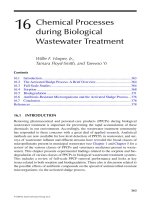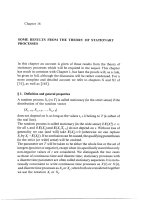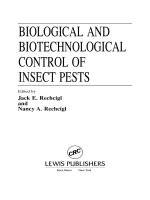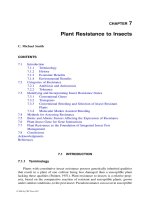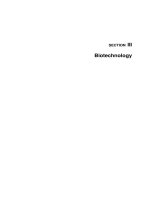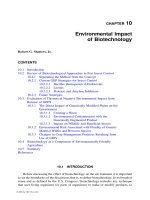Environmental Toxicology : Biological and Health Effects of Pollutants - Chapter 16 ppsx
Bạn đang xem bản rút gọn của tài liệu. Xem và tải ngay bản đầy đủ của tài liệu tại đây (715.66 KB, 16 trang )
Chapter 16
Environmental Cancer
16.1 INTRODUCTION
Cancer refers to any of a group of diseases characterized by uncontrolled
growth and spread of abnormal cells. In the scientific or medical community,
the term malignant neoplasm (tumor) is often used in place of cancer.
Malignant tumors develop most commonly in major organs, such as the
lungs, liver, stomach, intestines, skin, breasts, or pancreas, but they may also
develop in lips, tongue, testes, or ovaries. Cancer may also develop in the
blood-cell-forming tissues of the bone marrow (the leukemias) and in the
lymphatic system or bones.
In recent decades there has been growing concern about the possible effects
of a large number of environmental toxicants on carcinogenesis. As noted in
previous chapters, cancer incidence and mortality have increased dramatically
over the past century. Researchers consider that there are two main reasons for
the observed increase: the aging of the population, and an increase of
carcinogens present in and released into the environment through human
activities. Studies show that nearly 30% of the total mortality in many
industrialized countries is attributed to cancer. In the U.S., can cer remains the
number-two killer, accounting for nearly one fourth of all deaths. Despite the
recent decline in the mortality rate, the total number of cancer deaths continues
to rise as the elderly population increases. For example, the death toll in the
U.S. in 1980 was 416,509, in 1995 it was 538,455,
1
and it is estimated to be
556,500 in 2003.
2
One of the most common characteristics of the development of a neoplasm
in an organism is the long period of time between the initial application of a
carcinogenic (cancer-causing) agent, or carcinogen, and the appearance of a
neoplasm. The latency period varies with the type of carcinogen, its dosage,
and certain characteristics of the target cells within the host. In humans, cancer
may not be manifested until at least 10 or more years after an initial exposure
to a carcinogen.
16.2 CAUSES OF CANCER
Many factors can lead to cancer. These factors include: diet, smoking, alcohol,
reproductive and sexual behavior, occupational hazard, geo graphical factors,
and environmental agents. An estimate of the contribution of various agents or
life styles to the cause of cancers is presented in Table 16.1. It is notable that
[16:51 26/8/04 P:/CRC PRESS/4365 MING-HO.751 (1670)/4365-016.3d] Ref: 4365 MING-HO YU Chap-016 Page: 279 279-294
# 2005byCRCPressLLC
diet and smoking account for approximately two thirds of all cancers. Smoking
is particularly implicated in lung and bladder cancers.
Although there are many theories concerning the causes of cancer, the
fundamental principle underlying these theories is the alteration of the genetic
material of the cell, the DNA. The various theories attempt to explain how this
change is brought about. The DNA of a cancer cell is sligh tly different from
that of a normal cell. This means that the sequence of the bases – adenine (A),
guanine (G), thymine (T), and cytosine (C) – in a given strand of DNA is not
the same as that of the bases in a normal cell. As mentioned in Chapter 15,
these sequences dictate the sequences of the transcribed messenger RNA
(mRNA), which in turn specify the kinds of proteins to be synthesized in a cell.
Alteration in the DNA base sequence in cancer cells results in abnormal
proteins. These new proteins influence the mechanisms of growth control in
such a way that cell division continues indefinitely.
As discussed in Chapter 15, several types of DNA damage can occur. The
most common ones include: single- and double-strand breaks in the DNA
backbone, formation of crosslinks between DNA bases and between DNA
bases and proteins, and chemical addition to the DNA bases. These alterations
can result from exposure to radiation and to chemical, biological, and genetic
factors (Tab le 16.2). For example, ionizing radiations, such as x-rays and g-
rays, can produce DNA single- and double-strand breaks and various forms of
damage to bases. Ultraviolet (UV) light, which is a non-ionizing radiation, is
capable of producing dimers. A variety of chemicals can cause DNA damage
through base alterations. Alteration may be induced directly through
formation of adducts, or indirectly through intercalation formed by a chemical
between two bases. Many electrophilic chemicals can react with DNA, forming
covalent additional products termed adducts. For example, alkylating agents
can yield a reactive alkyl group that can react with base material, such as
guanine, to produce an adduct.
280 Environmental Toxicology
[16:51 26/8/04 P:/CRC PRESS/4365 MING-HO.751 (1670)/4365-016.3d] Ref: 4365 MING-HO YU Chap-016 Page: 280 279-294
Table 16.1 Speculative Proportion of Cancer Deaths
Attributed to Various Factors
Factor or class of factors Percent of all cancer deaths
Diet 35
Tobacco 30
Reproductive and sexual behavior 7
Occupational hazards 4
Geophysical factors 3
Alcohol 3
Pollution 2
Industrial products 1
Medicine and medical procedures 1
Infection 10?
Unknown ?
Source: Adapted from USDHHS, The Surgeon General’s Report on
Nutrition and Health, U.S. Government Printing Office, Washington,
D.C., 1988.
# 2005byCRCPressLLC
16.3 STAGES IN THE DEVELOPMENT OF CANCER
It is generally accepted that the pathway leading to carcinogenesis includes
three stages: init iation, promotion, and progression (Figure 16.1).
3
Initiation
results from a simple mutation in one or more cellular genes that control key
regulatory pathways of the cell. It requires cell division for the fixation of the
process. Unlike promotion or progression, initiation is irreversible in a viable
cell.
4
The efficiency of initiation is sensitive to xenobiotic and oth er chemical
factors, and the stage can be altered by both endogenous and exogenous
factors. For example, a variety of chemicals in different tissues can inhibit the
metabolism of a procarcinogen to an ultimate carcinogen (see Section 16.6),
thereby blocking the initiation process. Initiators may also produce trans-
Environmental Cancer 281
[16:51 26/8/04 P:/CRC PRESS/4365 MING-HO.751 (1670)/4365-016.3d] Ref: 4365 MING-HO YU Chap-016 Page: 281 279-294
Table 16.2 General Classification of Carcinogenic Agents
Class Example
Radiation Ultraviolet and ionizing radiations
Chemical Polycyclic aromatic hydrocarbons, aromatic amines and halides, benzene, vinyl
chloride, aflatoxin B
1
, urethane, asbestos, certain metals, diet, and tobacco
smoke
Genetic Viruses
Biological Transgenesis by enhancer–promoter–oncogene constructs
FIGURE 16.1 Three stages of carcinogenesis.
Source: Adapted from USDHHS, The Surgeon General’s Report on Nutrition and Health, 1988.
# 2005byCRCPressLLC
formed cells that can persist for the life-span of an individual without
producing cancer. In such cases, the damaged gene in the transformed cells
remains recessive because the damaged gene does not express an abnormal
protein.
Promotion results from the selective functional enhancement of signal
transduction pathways induced in the initiated cell and its progeny by the
continuous exposure to the promoting agent.
4
This stage involves gene
activation, leading to the synthesis of the abnormal protein. Rapid cell division
then occurs, which is accompanied by interruption of the organism’s normal
functions or health. Promotion then leads to the express ion of the genetic
changes as malignancy, which involves loss of control over cellular prolifera-
tion. Examples of promoting agents include: saccharin, butylated hy droxyto-
luene, 2,3,7,8-tetrachlorodibenzo-p-dioxin (TCDD, see Chapter 13), and
androgens and estrogens. In contrast to initiation, promotion is reversible.
Therefore, if the promoting agent is withdrawn well before tumors are
manifested, the appearance of tumors can be delayed or prevented.
Furthermore, promotion may be continually modulated by various environ-
mental factors, including frequency with which the promoting agent is
administered, age and sex of the subject, hormonal balance, and composition
and amount of diet. Research shows that many promoting agents exert their
effects on the cell through mediation of receptor mechanisms.
5
Some chemicals act as both initiat ors and promoters. Benzo(a)pyrene is
such a chemical. In small doses it initiates genetic damage, and in higher or
repeated doses, it enhances promotion.
Promoting agents involved in the onset of promotion do not cause cancer
by themselves; they only have a specific impact on an initiated cell. Promotion
is gradual, and some of the earlier steps are reversible. In the promotion stage,
abnormal proliferation of the affected cell occurs, presumably because of a
high concentration of growth factors or modified cell-surface receptors. If the
damage to the gene is not drastic, most of the normal components of the cell
will be produced and will be responsive to normal growth-inhibiting factors.
Experiments with animals suggest that the time lapse between initiation and
promotion is not critical. During the latter stage of promotion, however,
cumulative genetic changes occur, leading to totally irreversible neoplastic
transformation.
Progression results from continuing evolution of an unstable karyotype.
This stage usually develops from cells in the stage of promotion, but, in certain
conditions, it may develop directly from normal cells. The critical molecular
characteristic of this stage is karyotypic instability, and morphologically
discernible changes in cellular or genomic structure occur.
4
Furthermore,
benign or malignant tumors may be observed in this stage. The growth of
altered cells is sensitive to environmental factors during the early phase of
progression.
282 Environmental Toxicology
[16:51 26/8/04 P:/CRC PRESS/4365 MING-HO.751 (1670)/4365-016.3d] Ref: 4365 MING-HO YU Chap-016 Page: 282 279-294
# 2005byCRCPressLLC
16.4 METASTASIS
The most fearsome aspect of cancer is the spread of malignant cells from the
primary site to other parts of the body – a process called metastasis. This is the
late stage of the diseas e and is characterized by invasive activity and the
appearance of a variety of cancer-cell types. Some of the cells that have the
inherent ability to detach from the primary site eventually travel via the blood
or lymph to start a secondary tumor at another site. Metastasis is the primary
cause of the failure of treatment in cancer patients. The extent of the
dissemination of the malignant cells is determined by the physiological
condition of the host. During metastasis, continuous changes occur in the
tumor, and the function and behavior of the tumor cells in the late stage are
quite different from those in the early stage. Most frequently, the location of
metastasis is in the organ or organs that are served by blood vessels from the
original cancer site. Notably, growth and survival of a tumor require
nourishment, which is provided by new blood vessels near the tumor site.
16.5 CLASSIFICATION OF CARCINOGENS
Carcinogens are divided into two groups: Part A and Part B (based on a list
prepared by the U.S. National Toxicology Program, see Appendix 3). Part A
refers to those agents that are ‘‘Known to be a human carcinogen,’’ whereas
Part B refers to those that are ‘‘Reasonably anticipated to be a human
carcinogen.’’ Examples of carcinogens belonging to Part A include: aflatoxins,
inorganic arsenic compounds, asbestos, benzene, beryllium, coal tars, dioxin,
diethylstilbestrol, tobacco smoking, steroidal estrogens, nickel compounds,
radon, vinyl chloride, and UV radiation (see Appendix 3, Part A). More than
one hundred agents are included in Part B (see Appendix 3, Part B).
As noted earlier, the basic changes in DNA that can lead to cancer, i.e.,
mutation, can be caused by many agents. These agents are generally divide d
into four categories: radiation, chemical, biological, and genetic (Table 16.2).
3
Although mutation does not necessarily result in cancer, cancer occurs if the
proteins that are produced following mutation affect cell ular growth-control
mechanisms. The following section discusses in some detail the agents that can
cause DNA damage. Emphasis is placed on radiation and chemical agents.
16.5.1 R
ADIATION
The process involved in radiation-induced DNA damage is complex and has
received much attention over many years. As noted previously, ionizing
radiation produces a wide variety of DNA lesions, including various base
modifications, strand breaks, and DNA-protein crosslinks.
6
It was men tioned
in Chapter 15 that absorption of short-wave UV radiation by DNA causes
breakage in its strands, the opening of the rings of its bases, and the formation
of thymine dimers.
Environmental Cancer 283
[16:51 26/8/04 P:/CRC PRESS/4365 MING-HO.751 (1670)/4365-016.3d] Ref: 4365 MING-HO YU Chap-016 Page: 283 279-294
# 2005byCRCPressLLC
UV radiation is the main cause of skin cancer. Increased UV radiation
exposure– much of it is caused by sunbathing or tanning under a UV lamp – is
the main contributing factor to the rising incidence of skin cancer worldwide.
UV radiation induces formation of free radicals, especially reactive oxygen
radicals. Of the three types of UV radiation (UV-A, -B, and -C), UV-B is the
most harmful type. UV-B (which has a wavelength of 280 to 320 nm) is
attenuated by the earth’s ozone layer. Several other factors modulate the
amount of UV radiation to which people are exposed, including time of day,
season, humidity, and distance from the equator. Skin cancer risk is also
affected by skin type; fair skin that freckles or bumps easily is at more risk than
very darkly pigmented skin. People who live in sunny climates and have red or
blond hair and blue or light-col ored eyes are at especially high risk.
Among the photochemical reactions that take place when UV-B penetrates
the skin is mutation of the DNA in skin cells. Humans have repair enzymes
that can correct this damage, but mutations accumulate as the individual ages.
An individual’s lifestyle may also cause the repair system to eventually become
overtaxed, resulting in skin cancer. Most researchers stress that the damage
begins accumulating early – in childhood; by young adulthood about 50 % of
lifetime sunlight exposure may have already accumulated.
16.5.2 C
HEMICAL CARCINOGENS
The association between exposure to chemicals and cancer incidence was first
reported in 1775 by the English physician Percivall Pott, following the
observation of scrotal cancer in chimney sweeps.
7
With an increase in
European industrial development during the 19th century, high rates of skin
cancer were observed among workers in the shale oil and coal tar industries. In
1915, a group of Japanese scientists conducted experiments in which they
painted rabbits with coal tar and induced tumors. This led to the knowledge
that the compounds contained in the coal tar could produce cancer in animals.
Several groups of organic compounds have now been recognized as
carcinogenic to laboratory animals. These include polycyclic aromatic hydro-
carbons (PAHs), aromatic amines, aminoazo dyes, nitroso compounds,
benzene, and vinyl chloride.
8
Many chemical agents that may be found in foods are also known to cause
cancer. For example, aflatoxin B
1
, which causes liver cancer in several species
of test animals, is produced by Aspergillus flavus found in contaminated peanut
or cottonseed meal. There are also naturally produced substances that are
carcinogenic.
A number of inorganic substances have also been shown to induce cancer.
These include some salts of arsenic (As), beryllium (Be), cadmium (Cd),
chromium (Cr)(VI), nickel (Ni), and lead (Pb). It should be pointed out that
some of these metals are essential nutrients for humans and animals. Trival ent
Cr (Cr
3þ
) is one of these metals. As part of the glucose tolerance factor, Cr
plays an important role in maintaining normal glucose metabolism in
mammals.
284 Environmental Toxicology
[16:51 26/8/04 P:/CRC PRESS/4365 MING-HO.751 (1670)/4365-016.3d] Ref: 4365 MING-HO YU Chap-016 Page: 284 279-294
# 2005byCRCPressLLC
Several chlorinated hydrocarbons and other chemicals have been identified
as carcinogenic. These include 2,4-D, DDE, hexachlorocyclohexane, poly-
chlorinated biphenyls (PCBs), and polychlorinated dibenzo-p-dioxins
(PCDDs) (see Chapter 13).
16.6 METABOLISM OF CHEMICAL CARCINOGENS
As shown in Figure 16.1, chemical carcinogens are divided into two broad
classes: direct carcinogens and procarcinogens. Direct carcinogens are usually
electrophiles, such as H
þ
,C
þ
,N
þ
, and can react readily with nucleoph iles,
such as proteins and nucleic acids. The main sites in these molecules where such
reactions can occur are S, ¼N–, –C–OH, or –P–OH. Examples of cellular
nucleophiles include some amino acids, such as methionine, cysteine, histidine,
tryptophan, and tyrosine, and nucleic acid bases, such as adenine (N-1, N-3)
and guanine (C-8, N-7, O-6). Procarcinogens are those agents that require
biologic activation before becoming ultimate carcinogens. Compared with
direct carcinogens, procarcinogens are relatively stable, and so many people
may be environmentally or occupationally exposed to them. It is possible for
people to ingest or absorb some procarcinogens, after which enzymes in the
liver, lungs, or other organs convert them to their activated metabolites.
It is thought that most, and probably all, chemical carcinogens are
converted by metabolism into electrophilic reactants that exert their biological
effects by covalent interaction with DNA. Some examples of these reactants are
shown in Figure 16.2. Several of these chemicals are discussed in some detail in
the following sections. The discussion will focus on free radicals, DDT, vinyl
chloride, nitrosamine, ben zo[a]pyrene, and halogenated aromatic hydrocar-
bons.
16.6.1 F
REE RADICALS
Reactive oxygen species, such as hydroxyl radicals (OH
Á
), are produced during
the enzymatic and chemical reactions of molecular oxygen in cells. Hydroxyl
radicals are also produced when cells are exposed to ionizing radiation, tumor
promoters, and chemical carcinogens. As mentioned earlier, reactive oxygen
species can cause various lesions in DNA, by inducing damage to nucleic acids
and altering their structures an d function. Oxygen-induced lesions of nucleic
acids include strand breaks
9
and base modification products. Alternatively, the
OH
Á
free radical, formed through the reaction between superoxide free radical
(O
2
Á À
) and H
2
O
2
(Reaction 16.1), is unique and can induce breaks in the
phosphodiester bonds. Both single- and double-strand breaks can occur. In
addition, the free radical can abstract H-atoms from the DNA helix.
10
O
2
Á À
þ H
2
O
2
! O
2
þ HO
À
þ HO
Á
ð16:1Þ
Environmental Cancer 285
[16:51 26/8/04 P:/CRC PRESS/4365 MING-HO.751 (1670)/4365-016.3d] Ref: 4365 MING-HO YU Chap-016 Page: 285 279-294
# 2005byCRCPressLLC
16.6.2 DDT
DDT is one of the several pesticides that have been added to the long list of
cancer-causing agents present in the en vironment. According to a report by the
National Cancer Institute, women with high exposures to DDT may have a
greater risk of developing breast cancer. Researchers at Mt. Sinai Hospital in
New York City have found that women with blood levels of DDE (see Chapter
13) of 19 ng/ml have four times the risk of breast cancer compared with women
with levels of 2 ng/ml.
It is suggested that DDE may cause breast cancer in two ways: it may
induce cytochrome P450 enzymes, thereby altering the metabolism of
toxicants, or it may act as an estrogen mimic and as such may disrupt
the endocrine system through interaction with estrogen receptors (see
Chapter 14).
286 Environmental Toxicology
[16:51 26/8/04 P:/CRC PRESS/4365 MING-HO.751 (1670)/4365-016.3d] Ref: 4365 MING-HO YU Chap-016 Page: 286 279-294
FIGURE 16.2 Some examples of chemical carcinogens.
# 2005byCRCPressLLC
16.6.3 VINYL CHLORIDE
Vinyl chloride, the common name for monochloroethene (CH
2
¼CHCl), is
one of the most widely manufactured organic chemicals in the U.S. Vinyl
chloride is a gas at ambient temperature, with a boiling point of 14
C, and
exhibits a low solubility in water. While the vinyl chloride monomer itself is
rarely used, it is polymerized with itself and other organic compounds to
form many products, making it a very important chemical to industry and to
consumers.
Among the many polymers that are derived from vinyl chloride, polyvinyl
chloride (PVC) is the most common. PVC, as a solid material, is extremely
adaptable and cost effective, and is used in numerous construction materials,
home furnishings, packaging materials, automobile products, etc. Some
examples of the products made of PVC are water pipes, raincoats, credit
cards, wire coatings, and food packaging.
PVC production involves three stages: synthesis of vinyl chloride monomer
from petrochemicals and chlorine, polymerization of vinyl chloride into PVC
resin, and PVC fabrication. Environme ntal contamination occurs from these
processes, although the extent of it varies with each stage. The contamination
includes emission of vinyl chloride into the atmosphere, and surface and
groundwater contamination resulting from sludge and wastewater discharge.
Vinyl chloride has been shown to be both mutagenic and carcinogenic. It is
classified as a Part 1 carcinogen because sufficient evidence exists that the
compound is carcinogenic to humans. This is highly important because only
about 40 chemicals or chemical mixtures are classified as such.
11
Vinyl chloride
causes liver cancer in both humans and laboratory animals. However,
laboratory experiments with mice showed induction of not only liver can cer
but also cancers of bone, skin, lung, brain, nephron, and mammary tissues.
11,12
In humans, vinyl chloride exposure may occur both occupationally and non-
occupationally.
Vinyl chloride is metabolized by the hepatic cytochrome P450 enzymes to
the carcinogenic epoxide form. Studies show that this metabolite is an ultimate
carcinogen. It reacts with DNA, causing it to change its function. In the liver,
the active epoxide may be further converted to chloroethane aldehyde. A
molecule of glutathione can conjugate the aldehyde and the resultant co njugate
may then be excreted (Figure 16.3).
16.6.4 A
LKYLATING AGENTS
As noted in Chapter 15, alkylating agents are those chemicals that can react
with DNA to produce alkylated DNA adducts. Several groups of organic
compounds can be metabolized to alkylating agents. An example is N-nitroso
compounds, which consist of nitrosamines and nitrosamides. Nitroso com-
pounds are found in various types of food, particularly meat and meat
products (e.g., fried and cured meat products) and cheese. Small amounts of
the compounds have been shown to occur in beer, and tobacco smoke contains
Environmental Cancer 287
[16:51 26/8/04 P:/CRC PRESS/4365 MING-HO.751 (1670)/4365-016.3d] Ref: 4365 MING-HO YU Chap-016 Page: 287 279-294
# 2005byCRCPressLLC
varying amounts. Industrial exposure to N-nitrosamines accounts for another
environmental source. Occupation or industrial activities that may lead to
exposure include metal cutting and rolling, leather tanning, rubber manufac-
ture, handling of hydraulic fluids, and producing or using amines in the
chemicals industry. In these activities, exposure is mostly via air and skin.
13
The importance of nitrosamines as environmental carcinogens was first
postulated in 1962. Subsequent studies demonstrated the endogenous forma-
tion of such compounds from precursor amines and nitrite in vivo. The
endogenous formation of N-nitroso compounds from precursor amines and
nitrosating agents, particularly nitrite, is unique among the various chemical
carcinogens. Nitrosat able amine precursors, such as secondary and tertiary
amines, are natural constituents of food or contaminants of food, such as some
pesticides that can be nitrosated. Nitrite is the most important nitrosating
agent and is present in some food products. However, nitrite can also be
formed from nitrate in saliva and possibly in the intestines. The pathway
leading to the formation of an alkylating agent from dimethylamine is
presented in Figure 16.4. The first step is nitrosation in which dimethylamine
reacts with nitrite to form dimethylnitrosamine, a nitroso compound.
Metabolism of dimethylnitrosamine leads to the formation of a CH
3
þ
radical,
which can react with DNA, resulting in methylated DNA.
288 Environmental Toxicology
[16:51 26/8/04 P:/CRC PRESS/4365 MING-HO.751 (1670)/4365-016.3d] Ref: 4365 MING-HO YU Chap-016 Page: 288 279-294
FIGURE 16.3 Metabolism of vinyl chloride by the cytochrome P450 system.
FIGURE 16.4 Activation mechanism of dimethylamine.
# 2005byCRCPressLLC
16.6.5 POLYCYCLIC AROMATIC HYDROCARBONS
Polycyclic aromatic hydrocarbons (PAHs) are a group of compounds
composed of two or more fused aromatic rings. They are emitted into the
environment through both natural and anthropogenic combustion processes.
The two main sources of natural PAH productions are volcanic eruptions and
forest fires. Anthropogenic sources include combustion of fossil fuels by
automobiles and other transportation systems, petroleum-refining processes,
coking plants, asphalt production, industrial facilities that use fossil fuels,
effluent disposal, oil spills and refuse burning. PAHs are, therefo re, wi dely
distributed in all parts of the environment – air, soil, water, and sediments.
They are of major concern because they represent a potential human health
hazard through contamination of food and drinking water supplies. Estimated
carcinogenic PAH concentra tions in various environmental media are
presented in Table 16.3.
14
16.6.5.1 Benzo[a]pyrene
Among the many PAHs, benzo[a]pyrene (BaP) (Figure 16.5) is probably the
most widely known. In 1775, the British surgeon Percivall Pott first reported
the relationship between the incidence of cancer of the scrotum among chimney
sweeps and exposure to soot. Since then, many researchers have repeatedly
shown the potent carcinogenic effect of BaP. Sources of BaP emission include
burning of coal and refuse, residential furnaces, coke production, vehicle
Environmental Cancer 289
[16:51 26/8/04 P:/CRC PRESS/4365 MING-HO.751 (1670)/4365-016.3d] Ref: 4365 MING-HO YU Chap-016 Page: 289 279-294
Table 16.3 Estimated PAH Contents of Various
Environmental Media
Environmental medium PAH content
Outdoor air 2.6 to13.0 ng/m
3
Indoor air 1.5 to 13.0 ng/m
3
Surface water 8.0 ng/l
Groundwater 1.2 ng/l
Drinking water 2.8 ng/l
Rural soil 0.07 mg/kg dry wt
Urban soil 1.10 mg/kg
Road dust 137 mg/kg
Charcoal broiled or smoked beef 35 mg/kg
Pork 26 mg/kg
Poultry 12 mg/kg
Fish/shellfish 0.10 mg/kg
Smoked fish/shellfish 36 mg/kg
Green leafy vegetables 46 mg/kg
Grains 9 mg/kg
Fruits 2.4 mg/kg
Fluid milk 0.09 mg/kg
Fats and oils 66 mg/kg
Cheese 1.70 mg/kg
Alcohol beverage 0.08 mg/kg
# 2005byCRCPressLLC
disposal (open burning), wood burning, and forest and agricultural refuse
burning. BaP is found in most commercial motor oil, asphalt roofing and other
construction materials, and tobacco smoke (Table 16.4).
Like most PAHs, BaP is ubiquitous in the environment, being found in air,
water, soil, and food. According to Menzie et al.
14
the BaP concentrations in
58 prepared meals averaged 0.15 mg/kg, with a range of 0.005 to 1.17 mg/kg.
BaP can cause several forms of cancer, particularly cancers in the lung,
intestine, kidney, and liver. It has been reported that the ultimate carcinogenic
form of BaP is benzo(a)-7,8-diol-9,10-epoxide.
15
This active form of BaP is
formed through cytochrome P450-dependent activation followed by several
enzymatic steps. The resultant BaP metabolite then forms an adduct with the
base guanine in DNA, altering its function. Figure 16.5 summarizes the
activation process.
16.6.6 H
ALOGENATED AROMATIC HYDROCARBONS
As discussed in Chapter 13, halogenated aromatic hydrocarbons, including
polychlorinated dibenzodioxins (PCDDs), polychlorinated dibenzofurans
(PCDFs), and polychlorinat ed biphenyls (PCBs), are toxicants of much public
and scientific concern because of their widespread distribution in the
environment and the potential for human exposure from numerous sources.
As previously noted, exampl es of the sources include combustion processes,
contaminated pesticides, and industrial accidents or uncontrolled environ-
mental discharge. Humans may be exposed to these toxicants by such routes as
the inhalation of vapors, aerosols, or respi rable particles, the ingestion of
contaminated milk, meat, fish, water, and vegetation, and the dermal
absorption of contaminants in soil or from pesticides.
290 Environmental Toxicology
[16:51 26/8/04 P:/CRC PRESS/4365 MING-HO.751 (1670)/4365-016.3d] Ref: 4365 MING-HO YU Chap-016 Page: 290 279-294
FIGURE 16.5 Benzo[a]pyrene (BaP) and formation of BaP–guanine adduct.
# 2005byCRCPressLLC
PCDDs and some other halogenated aromatic hydrocarbons have been
shown to be carcinogenic in rats and mice.
16,17
Hepatocellular carcinomas were
produced in both species following dioxin exposure, but only female rats
developed squamous cell carcinomas of the lung, nasal turbinates, and hard
palate.
17
Ingestion of 0.1 mg/kg per day in the diet resulted in an increased
incidence of these tumors. In addition to hepatocellular carcinomas, follicul ar
cell adenomas of the thyroid were significantly increased in male rats and
female mice.
17
Other studies also reported a dose–dependent increase in tumors
of estrogen-sensitive organs, including breast , uterus, and pituitary.
18
This
suggests that PCDDs may be acting through a hormone-like mechanism. Most
evidence suggests that the carcinogenic activity of PCDDs results from a
receptor-mediated, nongenotoxic, promotional mechanism.
19,20
PCBs are carcinogenic in rodents, producing hepatocel lular carcinoma in
rats and hepatomas in mice.
20
The production of liver tumors in these species is
related to the degree of chlorination of the PCB mixt ure.
The halogenated aromatic hydrocarbons are believed to produce their toxic
effects through a common mechanism of action.
21
These compounds are able
to induce hepatic cytochrome P450 micr osomal enzyme systems, especially aryl
hydrocarbon hydroxylase (AHH) activity. It is generally accepted that the
toxic activity of these chemicals is related to their interaction with a cellular
receptor, the Ah receptor, which regulates the synthesis of a number of cellular
Environmental Cancer 291
[16:51 26/8/04 P:/CRC PRESS/4365 MING-HO.751 (1670)/4365-016.3d] Ref: 4365 MING-HO YU Chap-016 Page: 291 279-294
Table 16.4 Chemicals, Groups of Chemicals, Complex Mixtures and Industrial
Processes Causally Associated With Cancer in Humans
4-Aminobiphenyl Coal-tar pitch
Analgesic mixtures containing phenacetin Conjugated estrogens
Arsenic and certain arsenic compounds Cyclophosphamide
Asbestos Diethylstilbestrol
Azathioprine Melphalan
Benzene Methoxsalen with u.v. A therapy
Benzidine Mineral oils (some)
Betel quid with tobacco Mustard gas
N,N-Bis(2-chloroethyl)-2-naphthylamine 2-Naphthylamine
Bis(chloromethyl) ether and technical Shale oils
Grade chloromethyl methyl ether 1,4-Butanediol dimethylsulfonate
Certain combined chemotherapy for products Smokeless tobacco
Chlorambucil Soots
Chromium and certain chromium compounds Tobacco smoke
Coal tar
Auramine manufacture Isopropyl alcohol
Boot and shoe manufacture and repair Nickel refining
Coal gasification (older processes) Rubber
Coke production (certain exposures) Treosulphan industry (certain
occupations)
Furniture manufacture (wood dusts)
Underground hematite mining (with exposures to
radon)
Source: IARC Monographs on the Evaluation of the Carcinogenic Risk of Chemicals to
Humans, Supplement No. 4 (Updated).
# 2005byCRCPressLLC
proteins. As discussed in Chapters 13 and 14, the receptor is an intracellular
protein that binds to these biphenolic compounds based on stereo-specific
characteristics. Although the exact mechanism involved in the toxicity is not
known, it is thought that the toxicity results from interference with the control
of structural genes for several proteins through the binding of the Ah receptor
(see Figure 13.11).
16.7 DNA REPAIR
As noted earlier, DNA is damaged by a variety of chemical and physical
agents. Bases can be altered or lost, phosphodiester bonds in the backbo ne can
be broken, and strands can become covalently crosslinked. These lesions are
produced by ionizing radiation, UV light, and a variety of chemicals. It is
important to note that much of the damage sustained by DNA can be repaired
because genetic infor mation is stored in both strands of the double helix,
therefore information lost by one strand can be retrieved from the other.
22
A variety of enzymatic processes function to repair damaged DNA,
protecting cells from the potentially mutagenic and lethal effects of chemical
agent- and oxygen-induced damage. In mammalian systems, there are two
basic types of damage responses: repair mechanisms and tolerance mechan-
isms.
4
The repair mechanisms involve removal of the DNA damage, while the
tolerance mechanisms circumvent the damage without fixing it. A number of
enzyme systems exist, facilitating the repair. Four main steps are identified in
the repair process in which enzyme systems are involved:
1. Recognition of the lesion by endonucleases.
2. Removal of the damaged portion by exonuclease.
3. Replacement of the damaged section of DNA by polymerases.
4. Rejoining the uninjured parts by ligases.
Although the repair process is quite efficient, errors may occur. Some of the
errors may be expressed as visible chromosomal abnormalities, such as breaks,
deletions, translocations, ring chromosomes, and sister chromatid exchanges.
It is also considered likely that faulty DNA repair may lead to some mutations
and cancer.
16.8 REFERENCES
1. National Center for Health Statistics, 1997.
2. American Cancer Society, Cancer Facts and Figures 2003, ACS, Atlanta, GA,
2003, p.4.
3. U.S. Department of Health and Human Services, The Surgeon General’s
Report on Nutrition and Health, U.S. Government Printing Office, Washington,
D.C., 1988, 177.
292 Environmental Toxicology
[16:51 26/8/04 P:/CRC PRESS/4365 MING-HO.751 (1670)/4365-016.3d] Ref: 4365 MING-HO YU Chap-016 Page: 292 279-294
# 2005byCRCPressLLC
4. Pitot, H.C. and Dragan, Y.P., Chemical carcinogenesis, in Klaassen, C.D., Ed.,
Casarett & Doull’s Toxicology, 6th ed., McGraw-Hill, New York, 2001, p.241.
5. Pitot, H.C. and Dragan, Y.L.P., Facts and theories concerning the mechanisms
of carcinogenesis, FASEB J., 5, 2280, 1991.
6. Le, X.C. et al. Inducible repair of thymine glycol detected by an ultrasensitive
assay for DNA damage, Science, 280, 1066, 1998.
7. Cole, P. and Goldman, M.B., Persons at high risk of cancer. An approach to
cancer etiology and control, Fraumeni, J.F., Jr., Ed., Academic Press, New
York, 1975, p.1674.
8. Pitot, H.C., Fundamentals of Oncology, 3rd Ed., Marcel Dekker, New York,
1986.
9. Floyd, R.A., Role of oxygen free radicals in carcinogenesis and brain ischemia,
FASEB J., 4, 2587, 1990.
10. Cadenas, E., Biochemistry of oxygen toxicity, Annu. Rev. Biochem., 58, 79,
1989.
11. Van Duureen, B.L., Comparison of potency of human carcinogens: Vinyl
chloride chloromethylmethyl ether and bis(chloromethyl) ether, Environ. Res.,
49, 143, 1989.
12. Moss, A.R., Occupational exposure and brain tumors, J. Tox. Environ. Health,
16, 703, 1985.
13. Preussmann, R., Eisenbrand, G. and Spiegelhalder, B., Occurrence and
formation of N-nitroso compounds in the environment and in vivo,in
Emmelot, P. and Kriek, E., Eds., Environmental Carcinogenesis, Elsevier/
North-Holland Biomedical Press, Amsterdam. 1979, p.51.
14. Menzie, C.A., Potocki, B.B. and Santodonato, J., Exposure to carcinogenic
PAHs in the environment, Environ. Sci. Toxicol., 26, 1278, 1992.
15. Weinstein, I.B. et al., Benzo[a]pyrene diol epoxides as intermediates in nucleic
acid binding in vitro and in vivo, Science, 9, 592, 1976.
16. National Toxicology Program (NTP), Bioassay of 1,2,3,6,7,8- and 1,2,3,7,8,9-
Hexachlorodibenzo-p-dioxin for Possible Carcinogenicity. DHHS Publication
(NIH) 80-1754, DHHS, Washington, D.C., 1980.
17. National Toxicology Program (NTP), Bioassay of 2,3,7,8-Tetraclorodibenzo-p-
dioxin for Possible Carcinogenicity (Gavage Study), DHHS Publication (NIH)
82-1765, DHHS, Washington, D.C., 1982.
18. Kochiba, R.J. and Schwetz, B.A., Toxicity of 2,3,7,8-tetrachlorodibenzo-p-
dioxin (TCDD), Drug Metab. Rev., 13, 387, 1982.
19. Shu, H. P., Paustenbach, D. J., and Murray, F. J., A critical evaluation of the
use of mutagenesis, carcinogenesis, and tumor promotion data in a cancer risk
assessment of 2,3,7,8-tetraclorodibenzo-p-dioxin, Regul. Toxicol. Pharmacol.,
7, 57, 1987.
20. Kimbrough, R.D. et al., Induction of liver tumors in Sherman strain female
rats by polychlorinated biphenyl Aroclor 1260, J. Natl. Cancer Inst., 55, 1453,
1975.
21. Poland, A. and Knutson, J.C., 2,3,7,8-Tetrachlorodibenzo-p-dioxin and related
halogenated aromatic hydrocarbons: Examination of the mechanism of
toxicity, Annu. Rev. Pharmacol. Toxicol., 22, 517, 1982.
22. Stryer, L., Biochemistry, 3rd ed., W.H. Freeman & Co., New York, 1988,
p.694.
Environmental Cancer 293
[16:51 26/8/04 P:/CRC PRESS/4365 MING-HO.751 (1670)/4365-016.3d] Ref: 4365 MING-HO YU Chap-016 Page: 293 279-294
# 2005byCRCPressLLC
16.9 REVIEW QUESTIONS
1. What is cancer?
2. What are the two most important causes of cancer?
3. What are the three stages of carcinogenesis? Which of these is(are)
considered reversible?
4. What is the fundamental principle underlying the many theories about the
causes of cancer?
5. What is the main cause of skin cancer?
6. How does short-wave UV radiation affect DNA?
7. Which one is most harmful, UV-A, UV-B, or UV-C?
8. List five metals that can induce cancer.
9. What is metastasis? How does it occur?
10. What are procarcinogens?
11. In what way does the superoxide free radical affect cancer?
12. How does vinyl chloride become a carcinogen?
13. What are nitroso compounds? Explain the way in which nitroso compounds
can induce carcinogenesis.
14. Explain how BaP can be converted into its ultimate carcinogen.
15. How may DDE be related to carcinogenesis?
16. Explain the suggested mechanism by which dioxins act as a carcinogens.
17. Explain the mechanism that mammalian systems possess for repairing DNA
damage.
294 Environmental Toxicology
[16:51 26/8/04 P:/CRC PRESS/4365 MING-HO.751 (1670)/4365-016.3d] Ref: 4365 MING-HO YU Chap-016 Page: 294 279-294
# 2005byCRCPressLLC
